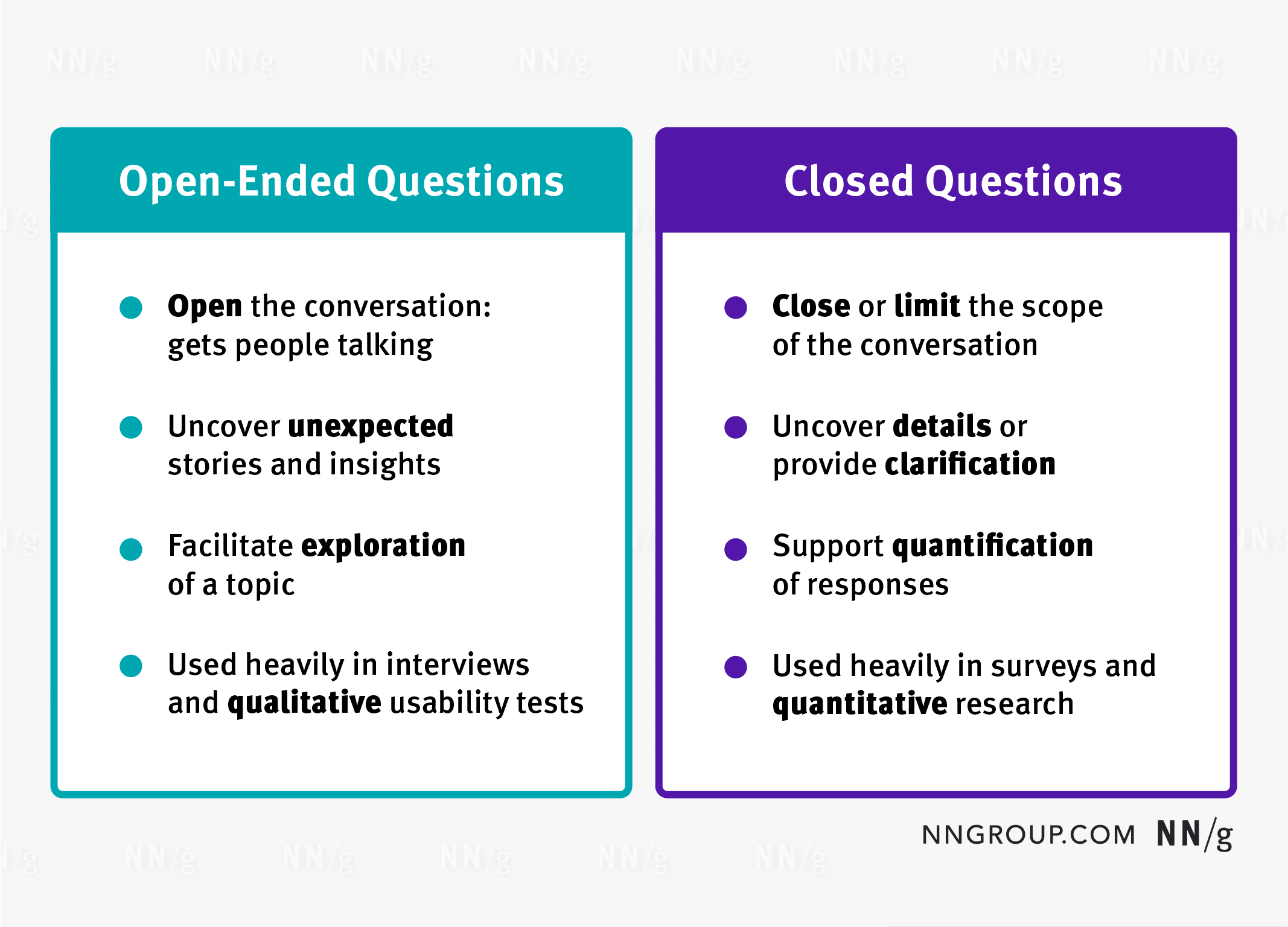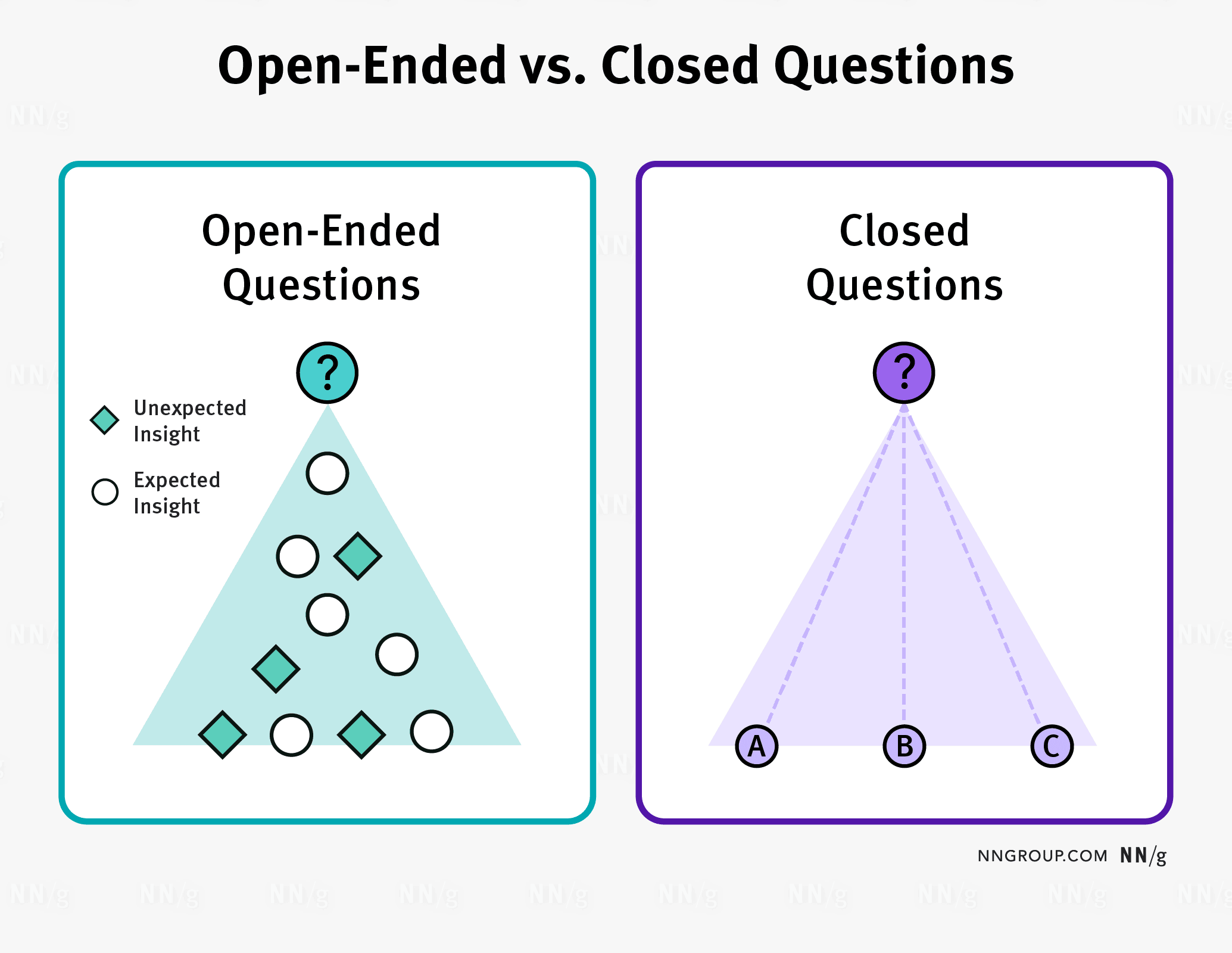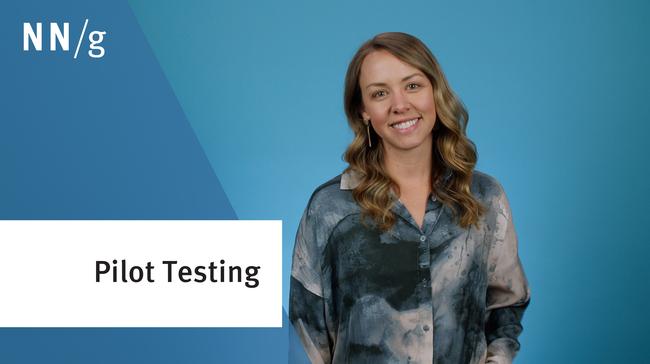When conducting user research, asking questions helps you uncover insights. However, how you ask questions impacts what and how much you can discover.
Open-Ended vs. Closed Questions
There are two types of questions we can use in research studies: open-ended and closed.
Open-ended questions allow participants to give a free-form text answer.
Closed questions (or closed-ended questions) restrict participants to one of a limited set of possible answers.
Open-ended questions encourage exploration of a topic; a participant can choose what to share and in how much detail. Participants are encouraged to give a reasoned response rather than a one-word answer or a short phrase.
Examples of open-ended questions include:
- Walk me through a typical day.
- Tell me about the last time you used the website.
- What are you thinking?
- How did you feel about using the website to do this task?
Note that the first two open-ended questions are commands but act as questions. These are common questions asked in user interviews to get participants to share stories. Questions 3 and 4 are common questions that a usability-test facilitator may ask during and after a user attempts a task, respectively.
Closed questions have a short and limited response. Examples of closed questions include:
- What’s your job title?
- Have you used the website before?
- Approximately, how many times have you used the website?
- When was the last time you used the website?
Strictly speaking, questions 3 and 4 would only be considered “closed” if they were accompanied by answer options, such as (a) never, (b) once, (c) two times or more. This is because the number of times and days could be infinite. That being said, in UX, we treat questions like these as closed questions.
In the dialog between a facilitator and a user below, closed questions provide a short, clarifying response, while open-ended questions result in the user describing an experience.
| Question | Example Response |
|---|---|
| Closed question: Have you used the website before? | Yes. |
| Open-ended question: Tell me about the last time you used the website. | I think it was last week. I was trying to find an article I could send to my colleague on how to do a usability test. I found a really nice one that had lots of visuals. |
| Closed question: How long did it take you, roughly, to find that article? | I can’t remember. Maybe 10 minutes? |
| Open-ended question: How did you decide which article to send your colleague? | There were quite a few of them when I searched “usability test”. I basically just skimmed the titles. I think I opened a few in new tabs and just quickly scanned it to make sure it had the right information… |
Using Closed Questions in Surveys
Closed questions are heavily utilized in surveys because the responses can be analyzed statistically (and surveys are usually a quantitative exercise). When used in surveys, they often take the form of multiple-choice questions or rating-scale items, rather than open-text questions. This way, the respondent has the answer options provided, and researchers can easily quantify how popular certain responses are. That being said, some closed questions could be answered through an open-text field to provide a better experience for the respondent. Consider the following closed questions:
- In which industry do you work?
- What is your gender?
Both questions could be presented as multiple-choice questions in a survey. However, the respondent might find it more comfortable to share their industry and gender in a free-text field if they feel the survey does not provide an option that directly aligns with their situation or if there are too many options to review.
Another reason closed questions are used in surveys is that they are much easier to answer than open-ended ones. A survey with many open-ended questions will usually have a lower completion rate than one with more closed questions.
Using Closed Questions in Interviews and Usability Tests
Closed questions are used occasionally in interviews and usability tests to get clarification and extra details. They are often used when asking followup questions. For example, a facilitator might ask:
- Has this happened to you before?
- When was the last time this happened?
- Was this a different time than the time you mentioned previously?
Closed questions help facilitators gather important details. However, they should be used sparingly in qualitative research as they can limit what you can learn.

Why Asking Open-Ended Questions Is Important
The greatest benefit of open-ended questions is that they allow you to find more than you anticipate. You don’t know what you don’t know. People may share motivations you didn’t expect and mention behaviors and concerns you knew nothing about. When you ask people to explain things, they often reveal surprising mental models, problem-solving strategies, hopes, and fears.
On the other hand, closed questions stop the conversation. If an interviewer or usability-test facilitator were to ask only closed questions, the conversation would be stilted and surface-level. The facilitator might not learn important things they didn’t think to ask because closed questions eliminate surprises: what you expect is what you get.

Closed Questions Can Sometimes Be Leading
When you ask closed questions, you may accidentally reveal what you’re interested in and prime participants to volunteer only specific information. This is why researchers use the funnel technique, where the session or followup questions begin with broad, open-ended questions before introducing specific, closed questions.
Not all closed questions are leading. That being said, it’s easy for a closed question to become leading if it suggests an answer.
The table below shows examples of leading closed questions. Reworking a question so it’s not leading often involves making it open-ended, as shown in column 2 of the table below.
| Leading Closed Question | Nonleading, Open-Ended Version |
|---|---|
| Was that experience helpful? | How did you find that experience? |
| Did that make sense? | What did you think about that? |
| Did you find that task difficult? | How did you find that task? |
| To what extent was the visual design a factor? | What factors did you consider? |
One way to spot a leading, closed question is to look at how the question begins. Leading closed questions often start with the words “did,” “was,” or “is.” Open-ended questions often begin with “how” or “what.”
How to Ask Open-Ended Questions
New interviewers and usability-test facilitators often struggle to ask enough open-ended questions. A new interviewer might be tempted to ask many factual, closed questions in quick succession, such as the following:
- Do you have children?
- Do you work?
- How old are you?
- Do you ever [insert behavior]?
However, these questions could be answered in response to a broad, open-ended question like Tell me a bit about yourself.
When constructing an interview guide for a user interview, try to think of a broad, open-ended version of a closed question that might get the participant talking about the question you want answered, like in the example above.
When asking questions in a usability test, try to favor questions that begin with “how,” or “what,” over “do,” or “did” like in the table below.
| Closed Question | Open-Ended Question |
|---|---|
| Do you normally…? | How do you normally…? |
|
Was it what you expected? Did you expect that? |
What did you expect? How was this different from what you expected? |
| Does this make sense to you? | What do you think about this? |
| Was it stressful? | How did you feel about that? |
| Did you know…? | How do you know…? |
Another tip to help you ask open-ended questions is to use one of the following question stems:
- Walk me through [how/what]...
- Tell me a bit about…
- Tell me about a time where…
Finally, you can ask open-ended questions when probing. Probing questions are open-ended and are used in response to what a participant shares. They are designed to solicit more information. You can use the following probing questions in interviews and usability tests.
- Tell me more about that.
- What do you mean by that?
- Can you expand on that?
- What do you think about that?
- Why do you think that?
Conclusion
Ask open-ended questions in conversations with users to discover unanticipated answers and important insights. Use closed questions to gather additional small details, gain clarification, or when you want to analyze responses quantitatively.




